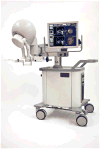Optimization of prostate biopsy: review of technique and complications
- PMID: 24725491
- PMCID: PMC4151475
- DOI: 10.1016/j.ucl.2014.01.011
Optimization of prostate biopsy: review of technique and complications
Abstract
A 12-core systematic biopsy that incorporates apical and far-lateral cores in the template distribution allows maximal cancer detection and avoidance of a repeat biopsy while minimizing the detection of insignificant prostate cancers. Magnetic resonance imaging-guided prostate biopsy has an evolving role in both initial and repeat prostate biopsy strategies, potentially improving sampling efficiency, increasing the detection of clinically significant cancers, and reducing the detection of insignificant cancers. Hematuria, hematospermia, and rectal bleeding are common complications of prostate needle biopsy, but are generally self-limiting and well tolerated. All men should receive antimicrobial prophylaxis before biopsy.
Keywords: Biopsy core number; Magnetic resonance imaging; Prostate needle biopsy; Quinolone-reistant infection.
Copyright © 2014 Elsevier Inc. All rights reserved.
Figures



References
-
- Taneja SSBM, Carter HB, Schellhammer P, Cookson MS, Gomella LG, Troyer D, Wheeler TM, Schlossberg S, Penson DF. White Paper: AUA/Optimal Techniques of Prostate Biopsy and Specimen Handling. 2013 http://www.auanet.org/common/pdf/education/clinicalguidance/Prostate-Bio.... - PMC - PubMed
-
- Babaian RJ, Toi A, Kamoi K, Troncoso P, Sweet J, Evans R, Johnston D, Chen M. A comparative analysis of sextant and an extended 11-core multisite directed biopsy strategy. J Urol. 2000;163:152–7. - PubMed
-
- Guichard G, Larre S, Gallina A, Lazar A, Faucon H, Chemama S, Allory Y, Patard JJ, Vordos D, Hoznek A, et al. Extended 21-sample needle biopsy protocol for diagnosis of prostate cancer in 1000 consecutive patients. Eur Urol. 2007;52:430–5. - PubMed
-
- de la Taille A, Antiphon P, Salomon L, Cherfan M, Porcher R, Hoznek A, Saint F, Vordos D, Cicco A, Yiou R, et al. Prospective evaluation of a 21-sample needle biopsy procedure designed to improve the prostate cancer detection rate. Urology. 2003;61:1181–6. - PubMed
Publication types
MeSH terms
Grants and funding
LinkOut - more resources
Full Text Sources
Other Literature Sources
Medical

